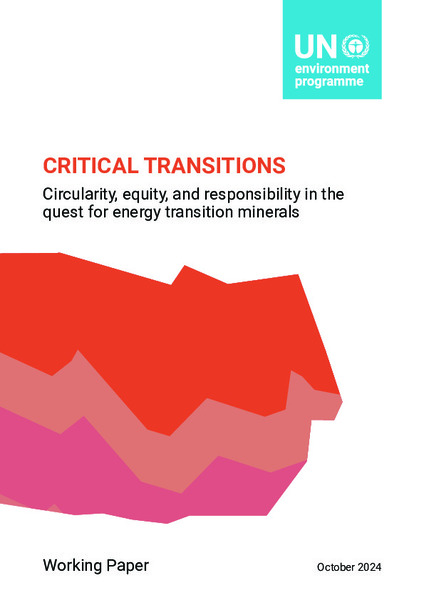| dc.contributor | Industry and Economy Division | en_US |
| dc.contributor.author | United Nations Environment Programme | en_US |
| dc.date.accessioned | 2024-11-18T09:18:47Z | |
| dc.date.available | 2024-11-18T09:18:47Z | |
| dc.date.issued | 2024-11 | |
| dc.identifier.isbn | 978-92-807-4195-7 | |
| dc.identifier.other | DTI/2682/NA | |
| dc.identifier.uri | https://wedocs.unep.org/20.500.11822/46623 | |
| dc.description | The world needs vast quantities of minerals to leave the fossil fuel age behind, but these must be produced in a manner that is neither socially nor environmentally damaging. And, it needs to be done quickly.
Unless the minerals used to equip the energy transition are extracted and managed responsibly and efficiently, and the benefits shared equitably across producer and consumer countries, the transition could have negative consequences on communities, development and the environment. Under a business-as-usual scenario, more ambitious climate goals, imply more intensive
mineral needs (Ekins et al. Forthcoming).
This paper outlines a vision for a future where more efficient, circular and responsible use of energy transition minerals equips the green transition, while concurrently meeting climate, biodiversity and pollution goals. | en_US |
| dc.format | pdf | en_US |
| dc.language | English | en_US |
| dc.publisher | United Nations Environment Programme | en_US |
| dc.subject | circular economy | en_US |
| dc.subject | mineral | en_US |
| dc.subject | equity | en_US |
| dc.subject | mining | en_US |
| dc.subject | sustainable energy | en_US |
| dc.subject | recycling | en_US |
| dc.title | Critical Transitions: Circularity, equity, and responsibility in the quest for energy transition minerals - Working Paper | en_US |
| dc.type | Publications | en_US |
| dc.type | Working Papers | en_US |
| wd.identifier.sdg | SDG 7 - Affordable and Clean Energy | en_US |
| wd.topics | Finance and Economic Transformations | en_US |
| wd.identifier.pagesnumber | 24 | en_US |
| wd.identifier.doi | https://doi.org/10.59117/20.500.11822/46623 | |


